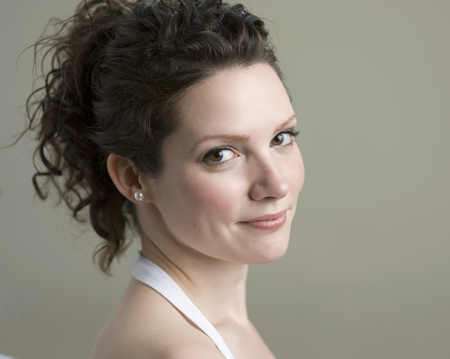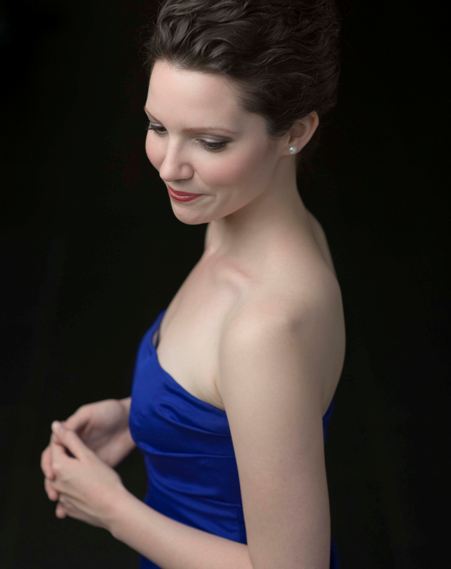-
Mireille Asselin Sings Semele
By Cecily CarverPosted in 2011/2012
Our spring season comes with an extra treat: the young artists of our Ensemble Studio, who spend one to three years singing and training with the COC at the beginning of their careers, will be appearing in their own special performance of Semele. The sets, costumes and staging will be identical to the other performances, but Ensemble Studio members will sing all the roles.
Sopranos Mireille Asselin and Ambur Braid (who we talked to for Orfeo ed Euridice last spring) are sharing the role of Semele. I asked Mireille a few questions about the experience, and here's what she had to say:
CC: You and Ambur Braid are sharing the role of Semele. How will that work in performance?
MA: In our performance of Semele, Ambur and I will be swapping turns at intermission: I'll be on stage for the first half of the show, and she for the second half. Luckily, the amount of music that we get to sing is practically equal when split this way, and since there is a clear switch dramatically (in Semele's character) and vocally (in Handel's writing for the role) I'd say it almost seems made to be sung by two different singers!
CC: One of your arias is sung while flying. What’s it like to sing while suspended in the air?
MA: I must say, the experience of singing some of my favourite music while flying through the air over a 450-year-old temple is not one that I will soon forget. It's a complete thrill! I was worried at first that I would discover a new fear of heights during the flight test, but truthfully I think the hardest part of singing while suspended in a harness is simply keeping my mind focused. There are so many new sensations to process in that moment – your body is compressed around the abdomen, the acoustic sounds different from that height, you can't see the conductor as well – and so it's easy forget to breathe, to count, to perform. That will be my challenge; to forget that I'm flying and to proceed as if everything were normal.

CC: Which aria from Semele is your favourite to sing?
MA: This is a hard question, because I feel like the answer changes every day. Right now, I'd say that my favourite aria to sing is "Myself I Shall Adore" because it gives me the chance for a lot of play with ornaments and characterization. But if you catch me in a more wistful mood, I would probably go with Semele's gorgeous Act II aria "O sleep, why dost thou leave me?" because it's achingly heartfelt and genuine.
CC: What is your process for learning a new role, and how did it apply to Semele?
MA: It seems simple to say, but the first thing that I do with a new role is to sit down with the score, read through the whole libretto and highlight my part. It's the important initial step of taking stock of the project: wrapping your mind around how much music you need to learn, which pieces will require the most technical work and which sections will be the most difficult to memorize. This then allows you to chart out what to work on when.The perfect example in this opera is Semele's final aria "No, no, I'll take no less," which has killer (and I mean killer!) long lines of coloratura passage-work. It's the kind of thing that you need to start singing early, so that it's second nature by the time you have to put it on its feet in a staging. Once the vetting of the score is done and the notes are learned, you essentially start training for an opera marathon. You make sure you sing it regularly, and consecutively, and that you understand how you will need to pace yourself physically in order to finish as strongly as you started. And that doesn't only apply to the singing. There is an endless amount of work one can do in thinking about the character, researching the opera and the composer/librettist team and developing ideas about the project and what you want to bring to it.
In this particular case, we're blessed with an extremely wide array of sources for Greek mythology, with numerous different takes on the myths of Semele and her family members according to different authors. We have concrete sources that we can read, which Handel's librettist (William Congreve) probably also consulted as he was developing his own version of the story, and which can in turn influence our interpretation of the work. There is also the added step of ornamentation when working on a Handel opera, which does not apply to the preparation of every new role, and which I not-so-secretly find to be the most fun part of the whole process. How often do you get to write your own little twists and turns into an operatic score?
CC: What’s your take on the character? She can seem both silly and melancholy – which side wins out for you?
MA: Semele is a sad character. I don't mean that she is melancholy necessarily, but her story is sad. I believe that she truly does love Jupiter, and believes that she will be happy with him forever. However, as a mortal she is thrown into a world of gods who make her their plaything and this brings about her inevitable demise. To me, she is profoundly normal and real and shockingly modern at times. She falls in love with a powerful man, leaves all that she has ever known behind to be with him, becomes jealous and insecure in their relationship, and so her fear of losing her love turns in to a self-fulfilling prophecy. She is a naïve, beautiful, sometimes silly girl, who lives a sad story.Top and bottom photos: Mireille Asselin.
Middle photo: Jane Archibald in a scene from Semele, 2012. Photo by Michael Cooper.

